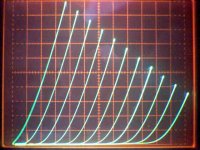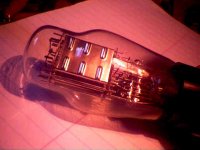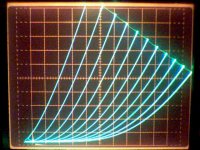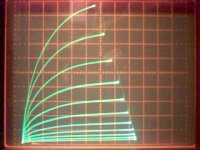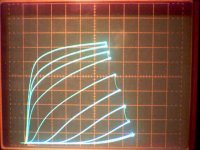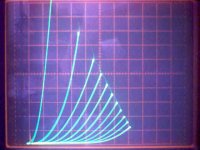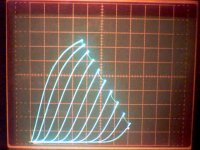Mu is about 32. Transconductance is 1500umho. Plate resistance is ~25k. So it's not a 12AX7/ECC83. Could be triode-connected EF86?
I'm sorry, what I meant to say was it looks as pretty as ECC83, a real existing triode that isn't hard to find and doesn't require any attention to perform this well. I wasn't referring to the specific set of tube parameters, merely the even spacing between grid lines.
Mu is about 32. Transconductance is 1500umho. Plate resistance is ~25k. So it's not a 12AX7/ECC83. Could be triode-connected EF86?
WINNER! You're good at this...
Yes it is a triode-strapped EF86 (a GEC to be exact) with 3.4V on the heater (yes!)
I got quite excited when I first saw this, but unfortunately none of my other EF86s (all Mullard) demonstrate this effect, at least, not nearly so well. Still, I thought it was an interesting curiosity.
Fascinating! I assume it would be quite noisy, as with such a cool cathode you would lose most of the space charge shot noise suppression and this would probably overcome the benefit of having less thermal noise from the cathode. It could be more noisy than an EF86 in pentode connection.
Merlin,
Interesting, starving this 'strapped pentode'.
How did you connect the auxiliary grids?
In the 6SJ7 datasheet (RCA, 1948) describes a triode connection: grids 2 & 3 connected to plate.
On the EF86 datasheet (Ph) the Screen 2 is connected to the anode and the 3 to the plate, a more conventional mode of course.
albert
Interesting, starving this 'strapped pentode'.
How did you connect the auxiliary grids?
In the 6SJ7 datasheet (RCA, 1948) describes a triode connection: grids 2 & 3 connected to plate.
On the EF86 datasheet (Ph) the Screen 2 is connected to the anode and the 3 to the plate, a more conventional mode of course.
albert
Now if the REAL perfect triode would please step forward:
Octal base, real tube, no resistors or cheats, triode configured (g3 to K, g2 to P), $3 each, never seen it mentioned before.
1 Volt per g1 step (starting at 0V)
2 mA/div. vertical
20 V/div. horizontal
Octal base, real tube, no resistors or cheats, triode configured (g3 to K, g2 to P), $3 each, never seen it mentioned before.
1 Volt per g1 step (starting at 0V)
2 mA/div. vertical
20 V/div. horizontal
Attachments
Last edited:
Now if the REAL perfect triode would please step forward:.....
I know - it isn't ZA5502

g3 to cathodeMerlin,
How did you connect the auxiliary grids?
g2 to anode via a 100 ohm resistor.
You all do realize that a perfectly linear triode would not sound any different than a good quality high-gain transistor amp with a ton of negative feedback, which is virtually perfectly linear? If you actually achieved such a thing (a linear triode), you would have made a fragile, hot, power-hungry, inefficient, short-lived, bulky, expensive device that has no advantages whatsoever over a cold chunk of silicon!
It's the non-linearity of tubes that has made them so beloved of so many electric guitarists and audio enthusiasts. It's that lovely non-linearity that makes up for all those disadvantages tubes have!
Just last night, as an experiment I played one of my semi-hollow electric guitars through a solid-state Acoustic AG-30 guitar amp, which is really intended for acoustic-electric guitars. It's a nice sounding amp especially with a touch of reverb added. Then I played the same guitar through the clean channel on my little Fender Super Champ XD, which has a 15 watt push-pull tube power section fronted by a solid-state preamp.
And suddenly the Acoustic amp didn't sound quite so good any more. The tubes in the Fender worked their magic, and that subtle shimmer and chime appeared in the guitar's tone. I added the same touch of reverb to the tube amp, and the tube sound got even prettier.
Thank goodness for nonlinear tubes!
-Flieslikeabeagle
It's the non-linearity of tubes that has made them so beloved of so many electric guitarists and audio enthusiasts. It's that lovely non-linearity that makes up for all those disadvantages tubes have!
Just last night, as an experiment I played one of my semi-hollow electric guitars through a solid-state Acoustic AG-30 guitar amp, which is really intended for acoustic-electric guitars. It's a nice sounding amp especially with a touch of reverb added. Then I played the same guitar through the clean channel on my little Fender Super Champ XD, which has a 15 watt push-pull tube power section fronted by a solid-state preamp.
And suddenly the Acoustic amp didn't sound quite so good any more. The tubes in the Fender worked their magic, and that subtle shimmer and chime appeared in the guitar's tone. I added the same touch of reverb to the tube amp, and the tube sound got even prettier.
Thank goodness for nonlinear tubes!
-Flieslikeabeagle
Hi,
Assuming this is a really old production EF86 (mesh etc) with an cute looking white and celeste decal on its glas I'm not all that surprised.
Soundwise these were the best EF86s ever. By a large margin.
I have a set of OTL monoblocks designed by Glenn Croft that uses a triode strapped EF86 at the input.
Try Telefunken, Mullard, Philips and so on that GEC was just incredible. Only the TFK E80F came close (which really isn't a EF86 but still).
There used to be more of these British gems. A2900 being one of them, some of the odd Brimar types as well.
Tube rolling....
I'm very glad you brought this one up as it shows how well the human ear can pick up on differences in distortions.
Distortions that won't even be noticed if the entire amp would be measured.
Cheers and keep digging up the gems,
WINNER! You're good at this...
Yes it is a triode-strapped EF86 (a GEC to be exact) with 3.4V on the heater (yes!)
I got quite excited when I first saw this, but unfortunately none of my other EF86s (all Mullard) demonstrate this effect, at least, not nearly so well. Still, I thought it was an interesting curiosity.
Assuming this is a really old production EF86 (mesh etc) with an cute looking white and celeste decal on its glas I'm not all that surprised.
Soundwise these were the best EF86s ever. By a large margin.
I have a set of OTL monoblocks designed by Glenn Croft that uses a triode strapped EF86 at the input.
Try Telefunken, Mullard, Philips and so on that GEC was just incredible. Only the TFK E80F came close (which really isn't a EF86 but still).
There used to be more of these British gems. A2900 being one of them, some of the odd Brimar types as well.
Tube rolling....
I'm very glad you brought this one up as it shows how well the human ear can pick up on differences in distortions.
Distortions that won't even be noticed if the entire amp would be measured.
Cheers and keep digging up the gems,
Hi,
If everything that measured the same also sounded the same I would still be into audio.
Some folk are only into measurements...............
Cheers,
You all do realize that a perfectly linear triode would not sound any different than a good quality high-gain transistor amp with a ton of negative feedback, which is virtually perfectly linear?
If everything that measured the same also sounded the same I would still be into audio.
Some folk are only into measurements...............
Cheers,
Now if the REAL perfect triode would please step forward:
That really is a very impressive set of straights (can't bring myself to call them curves!).
Warning... Long Shot approaching! Is it a triode connected 306A?
If everything that measured the same also sounded the same I would [SIC] still be into audio.
Some folk are only into measurements...............
=================================================================
And some folks choose to throw away all objectivity along with all science in the pursuit of emotion. It's an approach that is extremely limiting, and extremely profitable for a small number of manufacturers who take advantage of it. Basically, it's religion, not science or engineering.
If two things measure the same and do not sound the same, you're either making the wrong measurements, or you're fooling yourself.
It is actually quite easy to fool oneself, I've done it myself - I once convinced myself that I could hear a difference between two crossover networks - one analog and one digital - that had been equalized to within 0.3 dB of each other over the entire frequency range. Then I got two friends to join me and do a double-blind listening test, where I had to identify which speaker was which without knowing which one I was listening to, and without the other person in the room with me knowing which one was in use. Once we collected a statistically significant number of samples, I found out that I had only been fooling myself.
Many audio enthusiasts will not risk subjecting themselves to such a test, because they do not want to discover that their subjective opinion is in fact baseless. Too humiliating, if you take this stuff seriously.
But I digress.
There's a very simple objective test that will tell you if an amp adds anything at all to the sound of whatever is connected to it. You take the output voltage from the amp, divide it down with a couple of resistors, and subtract what's left from the actual input voltage, inverting the phase if necessary, and adjusting the resistor ratio for maximum cancellation.
What you're left with is the error signal, the difference between what the amp is putting out and what the input signal is doing. If the amp is perfect, this difference is zero. If the amp is imperfect, the imperfections show up here. In other words, if A and B are complex audio signals, and A-B is zero, then it is a mathematical fact that A = B.
With any number of good solid state amp designs, this difference signal turns out to be inaudibly small over the entire audio band. Not mathematically zero, but so small that it is barely measurable with good test equipment. If this difference signal were put through a loudspeaker, you couldn't even hear it in a silent room at a normal distance from the speaker. In actuality you would be hearing this already-inaudible sound added to the very loud full output signal. which may be 60 or 80 db stronger. In other words, there isn't a snowballs chance in hell that it could be heard.
Any amp that passes this test while playing actual audio material at actual listening levels and connected to actual loudspeakers, *IS* audibly perfect. Period. The difference between the output and input is inaudible, therefore by definition the amp is adding no audible change to whatever is going through it.
Certainly there are plenty of solid state amps that add audible amounts of hiss, hum, harmonic distortion, etc. All of them would fail this test.
Tube amps? The good ones - meaning the ones we like the sound of - won't pass this test. We like them because they do colour the sound, and that means they distort it.
Any tube amp that does pass this test will sound exactly like the transistor amps that passed it - i.e., they will have no sound of their own at all, being completely transparent. The classic "straight wire with gain" ideal.
Unless you go so far as to claim that A-B = 0 does not prove that A = B, there is simply no way to argue your way out of this test. And that particular claim would be so absurd that hopefully nobody would take it seriously (it would amount to saying that you expect some change back if you buy an item that costs $20 and pay with a $20 bill).
As far as I know, the famous audio engineer Peter Walker (he of the famous British audio company called Quad) was the first person to discuss this A-B test as a means of assessing amplifier performance. Even in the 1960's, he was able to design audio amps which had an inaudible output-input difference signal - while playing Beethoven or what have you, into actual loudspeakers. All the arguments subjectivists bring up about how actual music is different than sine wave testing, inductive speaker loads cause amps to distort, etc, etc are covered by this one simple test - and even fifty years ago, a good amp design could pass with flying colours.
There *are* plenty of imperfect things in the audio chain, but an audio amp with a flat frequency response, large damping factor, 0.005% THD over the entire audio band and a noise floor at -100 dB isn't one of them. And any amp with those specs is inaudible, i.e. adds nothing audible to the sound.
-Flieslikeabeagle
Some folk are only into measurements...............
=================================================================
And some folks choose to throw away all objectivity along with all science in the pursuit of emotion. It's an approach that is extremely limiting, and extremely profitable for a small number of manufacturers who take advantage of it. Basically, it's religion, not science or engineering.
If two things measure the same and do not sound the same, you're either making the wrong measurements, or you're fooling yourself.
It is actually quite easy to fool oneself, I've done it myself - I once convinced myself that I could hear a difference between two crossover networks - one analog and one digital - that had been equalized to within 0.3 dB of each other over the entire frequency range. Then I got two friends to join me and do a double-blind listening test, where I had to identify which speaker was which without knowing which one I was listening to, and without the other person in the room with me knowing which one was in use. Once we collected a statistically significant number of samples, I found out that I had only been fooling myself.
Many audio enthusiasts will not risk subjecting themselves to such a test, because they do not want to discover that their subjective opinion is in fact baseless. Too humiliating, if you take this stuff seriously.
But I digress.
There's a very simple objective test that will tell you if an amp adds anything at all to the sound of whatever is connected to it. You take the output voltage from the amp, divide it down with a couple of resistors, and subtract what's left from the actual input voltage, inverting the phase if necessary, and adjusting the resistor ratio for maximum cancellation.
What you're left with is the error signal, the difference between what the amp is putting out and what the input signal is doing. If the amp is perfect, this difference is zero. If the amp is imperfect, the imperfections show up here. In other words, if A and B are complex audio signals, and A-B is zero, then it is a mathematical fact that A = B.
With any number of good solid state amp designs, this difference signal turns out to be inaudibly small over the entire audio band. Not mathematically zero, but so small that it is barely measurable with good test equipment. If this difference signal were put through a loudspeaker, you couldn't even hear it in a silent room at a normal distance from the speaker. In actuality you would be hearing this already-inaudible sound added to the very loud full output signal. which may be 60 or 80 db stronger. In other words, there isn't a snowballs chance in hell that it could be heard.
Any amp that passes this test while playing actual audio material at actual listening levels and connected to actual loudspeakers, *IS* audibly perfect. Period. The difference between the output and input is inaudible, therefore by definition the amp is adding no audible change to whatever is going through it.
Certainly there are plenty of solid state amps that add audible amounts of hiss, hum, harmonic distortion, etc. All of them would fail this test.
Tube amps? The good ones - meaning the ones we like the sound of - won't pass this test. We like them because they do colour the sound, and that means they distort it.
Any tube amp that does pass this test will sound exactly like the transistor amps that passed it - i.e., they will have no sound of their own at all, being completely transparent. The classic "straight wire with gain" ideal.
Unless you go so far as to claim that A-B = 0 does not prove that A = B, there is simply no way to argue your way out of this test. And that particular claim would be so absurd that hopefully nobody would take it seriously (it would amount to saying that you expect some change back if you buy an item that costs $20 and pay with a $20 bill).
As far as I know, the famous audio engineer Peter Walker (he of the famous British audio company called Quad) was the first person to discuss this A-B test as a means of assessing amplifier performance. Even in the 1960's, he was able to design audio amps which had an inaudible output-input difference signal - while playing Beethoven or what have you, into actual loudspeakers. All the arguments subjectivists bring up about how actual music is different than sine wave testing, inductive speaker loads cause amps to distort, etc, etc are covered by this one simple test - and even fifty years ago, a good amp design could pass with flying colours.
There *are* plenty of imperfect things in the audio chain, but an audio amp with a flat frequency response, large damping factor, 0.005% THD over the entire audio band and a noise floor at -100 dB isn't one of them. And any amp with those specs is inaudible, i.e. adds nothing audible to the sound.
-Flieslikeabeagle
Now if the REAL perfect triode would please step forward:
Hummm, maybe my 306A guess was wrong.
Looks like Mu of 20, Rp of about 3k3...
...interesting!
Smoking-amp, thanks for those sets of curves!
It's very illuminating how much variation one tube type can have over another, compared to solid-state device curves which usually all have much the same shape, more or less fixed by the various physical processes operating in the device. For instance all diodes follow an exponential I-V curve over several decades of current, and all JFET's follow a square-law relationship between Vgs and Is pretty closely.
Your curves are enough to blow out of the water the idea that there is a semiconductor device that will produce a "tube sound". At best, perhaps one could approach the sound of one particular tube (some of those curves do look a bit like FET curves with the voltages suitably scaled, don't they?), without getting anywhere near the sound of some other tube model.
-Flieslikeabeagle
It's very illuminating how much variation one tube type can have over another, compared to solid-state device curves which usually all have much the same shape, more or less fixed by the various physical processes operating in the device. For instance all diodes follow an exponential I-V curve over several decades of current, and all JFET's follow a square-law relationship between Vgs and Is pretty closely.
Your curves are enough to blow out of the water the idea that there is a semiconductor device that will produce a "tube sound". At best, perhaps one could approach the sound of one particular tube (some of those curves do look a bit like FET curves with the voltages suitably scaled, don't they?), without getting anywhere near the sound of some other tube model.
-Flieslikeabeagle
Re: Gordy
The 306A has got a 5 pin base and a plate cap. (The mystery tube has an Octal base and no cap.) The 306A does have one crucial aspect in common with the "mystery" tube. But the 306A is 5 times bigger and not too likely available for $3. The 306A datasheet curves do look quite good and it could well be a super linear triode. I don't have one to test here though. The mystery tube was a junk box dust collector, fairly obscure, I just tried it on the tracer one day. Totally amazed. I'm sure there are a bunch of other undiscovered wonder tubes out there yet.
Re: Flieslikeabeagle
The extra grids are the key element. If some real short channel Fets with multiple gates were available....
The other side of the coin is that modern technology could allow tube designs in TO-264 packages now, without the filament/htr requirement, using field emitters or tunneling emitters. Graphene frame grids maybe? I suspect they actually may exist (or soon will) out there in classified microwave land.
The 306A has got a 5 pin base and a plate cap. (The mystery tube has an Octal base and no cap.) The 306A does have one crucial aspect in common with the "mystery" tube. But the 306A is 5 times bigger and not too likely available for $3. The 306A datasheet curves do look quite good and it could well be a super linear triode. I don't have one to test here though. The mystery tube was a junk box dust collector, fairly obscure, I just tried it on the tracer one day. Totally amazed. I'm sure there are a bunch of other undiscovered wonder tubes out there yet.
Re: Flieslikeabeagle
The extra grids are the key element. If some real short channel Fets with multiple gates were available....
The other side of the coin is that modern technology could allow tube designs in TO-264 packages now, without the filament/htr requirement, using field emitters or tunneling emitters. Graphene frame grids maybe? I suspect they actually may exist (or soon will) out there in classified microwave land.
- Status
- This old topic is closed. If you want to reopen this topic, contact a moderator using the "Report Post" button.
- Home
- Amplifiers
- Tubes / Valves
- Could this be a perfectly linear triode?
